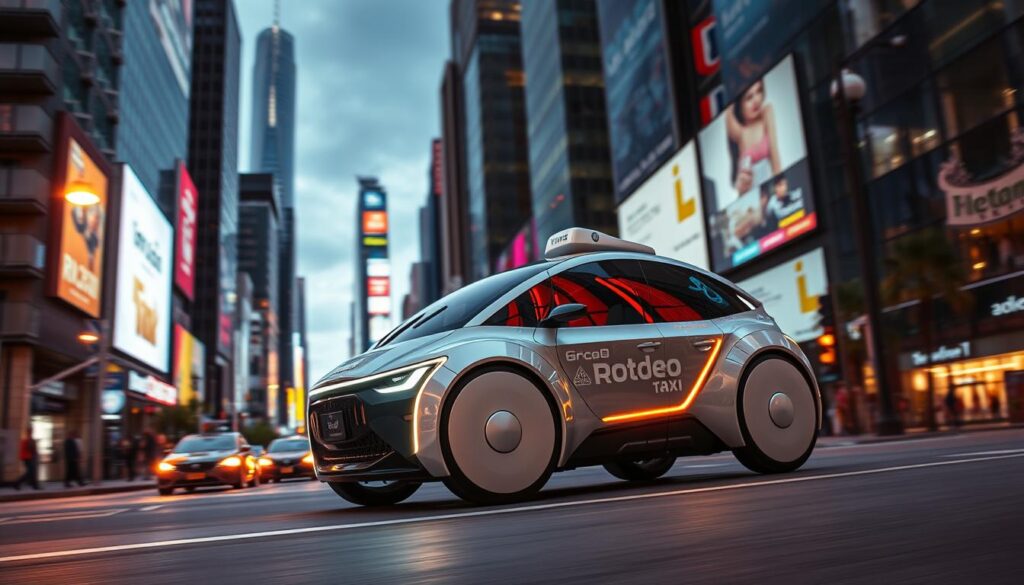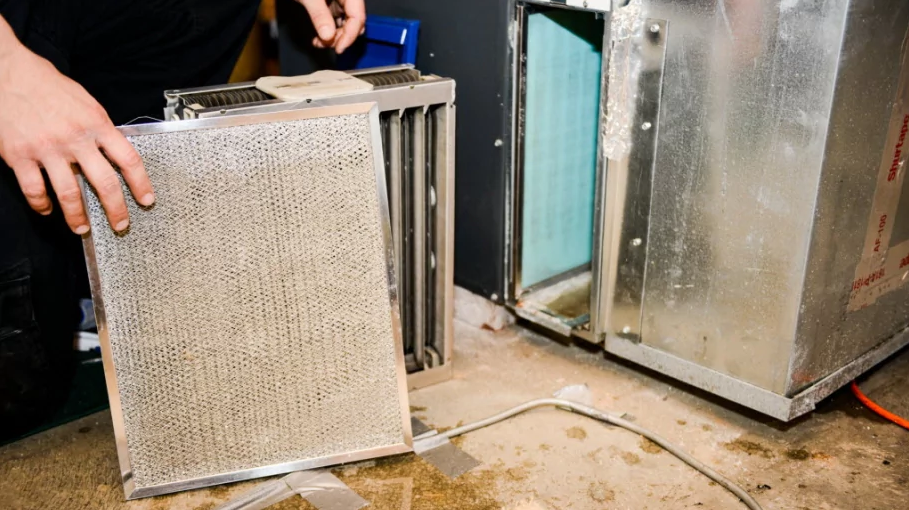
Top 7 Robot Taxi Companies Revolutionizing Transport
The future of transportation is here, and it’s all about self-driving cars. In 2022, this market was worth $22.45 billion. Experts predict it will jump to $64.12 billion by 2030, growing 14.02% each year. This growth comes from big investments by car makers and tech companies.
They see the benefits of less traffic, safer roads, and better city travel. But, getting to a future with self-driving cars isn’t easy. There are safety worries, rules to follow, and the need for good infrastructure.
Still, top companies are tackling these challenges. They’re creating new technologies and business plans to change how we travel. Let’s look at the top 7 robot taxi companies leading this change in transportation.
These companies are making the future of travel exciting. They’re working on advanced tech and new ways to move people around cities. In this article, we’ll dive into what makes these companies stand out in the self-driving car world.
Introduction: The Future of Transportation
The way we travel is changing fast, thanks to new robotaxi technology and self-driving cars. These changes are making city travel easier and more efficient. Companies leading in robotaxi are using the latest tech to change how we move around cities.
What Are Robot Taxis?
Robot taxis, or self-driving cars, use many advanced technologies. They have radar, LiDAR, cameras, and AI algorithms. These help them drive safely and take passengers without a human driver. This new way of traveling could make cities safer, less crowded, and easier to get around.
How Robot Taxis Are Transforming Urban Mobility
Robotaxi services are changing how we move in cities. They offer rides without a driver, which could cut down on traffic and make air cleaner. They also help people who can’t easily use regular transport. Plus, they work well with city planning, making cities run smoother.
Why These Companies Stand Out
Some companies are leading the way in robotaxi technology. Names like Waymo, Cruise, Tesla, and Baidu Apollo are at the forefront. They’re using new tech, making partnerships, and trying new business ideas to change city travel. Their work is tackling big challenges and making the future of travel exciting.
1. Waymo: Leading the Autonomous Revolution
Waymo, a part of Alphabet Inc. (Google’s parent), is a leader in self-driving cars. It has been working on this technology for over ten years. This work started as Google’s self-driving car project in 2009. Now, Waymo offers safe and reliable robotaxi services to people.
Key Technologies: LiDAR, AI, and Machine Learning
Waymo uses advanced tech like LiDAR, AI, and machine learning for driving on its own. Its cars have top-notch LiDAR sensors that make detailed 3D maps of the area. This helps the cars move safely and efficiently.
The AI and machine learning help the cars make smart choices and handle changing road conditions. They look at a lot of data from sensors to decide what to do next.
Deployment and Success Stories: Waymo’s Robot Taxi Service in Phoenix
In Phoenix, Arizona, Waymo’s robotaxi service has been a big hit. It has driven over 40 million miles on public roads. People in the area really like it, with over 50,000 paid rides every week.
This success has made people trust Waymo. It’s now planning to bring this service to more cities, like Austin, Texas.
Future Plans: Expansion and Challenges
Waymo is ready to grow its robotaxi service to more places. But, it faces big challenges. These include dealing with complex rules, changing how people see it, and solving tech problems.
Waymo needs to overcome these hurdles to keep leading in the self-driving car world. How it handles these challenges will show if it can stay ahead in the autonomous driving technology field.
2. Cruise: GM’s Bet on the Autonomous Future
Cruise, a part of General Motors (GM), is putting a big bet on the future of self-driving cars. GM is backing Cruise with a lot of resources. This shows GM’s big plans for changing how we move around.
Core Technologies: Electric and Autonomous Innovations
Cruise is all about mixing electric and self-driving tech to make better self-driving cars. Thanks to GM’s help, Cruise has made big improvements in its cruise autonomous vehicles. These cars are set to change how we travel.
Key Milestones: San Francisco Testing and Public Rollout
Cruise has hit some big milestones on its path to self-driving cars. It tested its self-driving car innovation in San Francisco, a tough city for tests. This has built excitement for its electric autonomous technology.
The Road Ahead: Cruise’s Vision for the Future
Cruise is always moving forward with a big plan for self-driving cars. With gm backing, it’s set to lead the industry. Cruise’s new ideas and strong focus on self-driving car innovation make it a key player in the future of mobility.
3. Tesla: Elon Musk’s Vision for Robotaxis
Tesla, led by Elon Musk, is leading the self-driving car revolution. Its Autopilot and Full Self-Driving tech stand out. But, the company’s plans for a robotaxi fleet face big challenges.
Autopilot and Full Self-Driving: What Sets Tesla Apart
Tesla’s Autopilot has features like lane-keeping and automatic emergency braking. Its Full Self-Driving (FSD) aims for a more complete autonomous experience. Tesla uses cameras and machine learning, unlike competitors who focus on LiDAR.
The Tesla Network: Plans for a Robotaxi Fleet
Elon Musk wants the Tesla Network to let owners rent out their cars for a robotaxi fleet. This plan would use Tesla’s tech for a self-driving transport system. But, it’s facing big hurdles, like getting regulatory approval and solving tech challenges.
Regulatory and Technological Hurdles: What’s Holding Tesla Back?
Regulators are questioning Tesla’s self-driving tech, citing safety and reliability concerns. The legal issues have slowed Tesla down. Also, the tech challenges, like camera limitations and sensor fusion, are making it hard to achieve full autonomy.
The Future of Tesla’s Robotaxis: Potential and Pitfalls
Tesla is still pushing for its robotaxi vision. The Tesla Network could change city travel, making it more accessible and green. But, it’s not without risks, like public doubts, competition, and tech and regulatory hurdles. Tesla’s journey with self-driving tech is exciting but uncertain.
4. Baidu Apollo: China’s Autonomous Driving Giant
Baidu is a top tech company in China, leading in autonomous driving with Baidu Apollo. It uses AI and big data to make big steps in self-driving cars. This makes Baidu Apollo a key player in the global push for autonomous cars.
The Baidu Advantage: AI and Big Data Integration
Baidu shines by combining AI and big data smoothly. It has a huge amount of data from its digital services. This data helps train its self-driving algorithms and improve its cars.
This approach, with Baidu’s AI tech, has led to fast progress in areas like seeing, predicting, and making decisions for self-driving.
Global Expansion: Baidu Apollo’s International Ambitions
Beyond China, Baidu Apollo aims to grow worldwide. It’s looking for chances in new markets, making key partnerships. With its strong tech and market knowledge, Baidu Apollo is set to lead in the global self-driving movement.
Partnerships and Collaborations: Working with Automakers
Baidu Apollo knows the value of working together in the car industry. It has teamed up with top car makers worldwide. These partnerships let Baidu add its self-driving tech to its partners’ cars and platforms. This creates a strong system that speeds up the use of self-driving cars.
Key Projects: Robotaxi Service in Beijing and Beyond
Baidu Apollo’s robotaxi service in Beijing is a big project. It’s growing its self-driving car fleet and area it covers. This shows what the future of city travel might look like.
Baidu Apollo plans to take its robotaxi service to more cities in China and around the world. This will make it a leader in the self-driving industry.
Baidu Apollo’s AI-powered self-driving tech, its push to grow globally, and its partnerships make it a big player in changing how we travel. As self-driving tech grows, Baidu Apollo is at the forefront, bringing new ideas and changing how we move.
| Key Metrics | Value |
|---|---|
| Autonomous Driving Distance Covered | Over 100 million kilometers without major accidents |
| Projected Robotaxi Fleet in China by 2040 | Around 12 million autonomous vehicles |
| Projected Expansion of Apollo Go Platform | 65 cities by 2025, potentially 100 cities by 2030 |
| Driverless Robotaxi Rides in Wuhan | 45% of total rides in Q4 2023 |
| Apollo Go Ride Growth | 49% increase in Q4 2023 year-over-year |
| Robotaxi Fleet Deployment in Wuhan | 1,000 6th Gen vehicles by 2024 |
5. Zoox: Amazon’s Autonomous Ambition
Amazon’s move to buy Zoox shook up the self-driving car world. Zoox is famous for its cutting-edge self-driving car design. This deal shows Amazon’s big plans for the future of getting around.
Acquired by Amazon: What It Means for Zoox
Amazon’s buyout of Zoox gave the startup the boost it needed. With Amazon’s help, Zoox can speed up its work on zoox autonomous vehicle design. They’ll use Amazon’s know-how in logistics and tech to make their self-driving tech better and faster.
Unique Vehicle Design: A Car Built for Autonomy
Zoox’s cars are special because they’re made just for self-driving. They can go both ways, making city streets safer and more efficient. This new way of designing cars could make Zoox a leader in the robotaxi market.
Testing and Development: From Las Vegas to San Francisco
Zoox has been testing its self-driving tech in places like zoox las vegas testing and zoox san francisco development. These tests help the company learn and improve its systems. This makes sure their cars are ready for lots of use.
Looking Forward: How Zoox Could Change the Game
With Amazon’s support, Zoox is set to make a big splash. Its unique cars and tech could change how we move around cities. The future of getting around might look very different thanks to Zoox.
6. AutoX: Pioneering Robotaxi Services in China and the U.S.
AutoX leads in autox robotaxi services, offering new solutions in China and the U.S. They use advanced autox ai mapping and local mapping skills. This approach helps them handle the challenges of different cities.
The AutoX Approach: Combining AI with Localized Mapping
AutoX blends AI and detailed local maps for autox china operations and autox us expansion. This mix lets their robotaxis adjust to each city’s roads, traffic, and unique features.
Key Markets: Focusing on China and Expanding in the U.S.
AutoX is strong in China but aims big in the autox us expansion. Through autox automotive partnerships, it’s growing fast. It’s working with top car makers to improve its robotaxi services in both countries.
Partnerships and Progress: Collaborations with Leading Car Manufacturers
AutoX’s autox global robotaxi strategy benefits from partnerships with big car companies. These alliances give AutoX access to industry insights, tech, and manufacturing know-how. This helps it lead in the robotaxi field.
Future Vision: AutoX’s Strategy for Global Robotaxi Dominance
AutoX is aiming high, planning to lead the autox robotaxi world. With its autox ai mapping skills and autox automotive partnerships, it wants to change urban travel. It plans to offer smooth, reliable self-driving transport globally.
7. Nuro: Redefining Autonomous Transport with Delivery Bots
Nuro is making waves in the self-driving taxi world with its focus on delivery robots. Based in Mountain View, California, Nuro uses small-scale autonomous tech to change how goods move in cities. They aim to make urban delivery services more efficient.
Nuro’s Unique Focus: Delivery Robots vs. Traditional Robotaxis
Nuro stands out by focusing on delivery, seeing a big chance for self-driving tech to change how goods move. Their robots are made for city streets, offering fast, last-mile delivery that fits with current transport systems.
Key Technologies: Small-Scale Autonomy for Urban Delivery
Nuro’s bots use the latest tech like lidar sensors, AI, and machine learning. By making their vehicles smaller, they can easily move through crowded cities and tight spots.
Partnerships and Deployments: Collaborating with Major Retailers
Nuro has teamed up with big names like 7-Eleven to test its delivery service. In 2020, they got a permit from the California DMV to start their service with 7-Eleven in Mountain View. This was the first time an autonomous delivery service was used in the state.
Future Growth: Expanding Beyond Delivery
Nuro is always improving its tech and growing its partnerships. The industry is watching to see how they’ll move beyond delivery. With a focus on city autonomy, Nuro is set to change the future of nuro autonomous delivery, nuro delivery robots, and nuro urban autonomy.
| Company | Headquarters | Founded | Employees | Latest Funding |
|---|---|---|---|---|
| Nuro | Mountain View, CA | 2016 | 1001-5000 | Series D |
| Velodyne Lidar | San Jose, CA | 2007 | 201-500 | Acquired |
| LILEE Systems | San Jose, CA | 2009 | 51-200 | N/A |
Challenges Facing the Robotaxi Industry
The robotaxi industry is leading the way in making cities move better. But, it’s not without its challenges. These challenges need to be solved for robotaxis to become a big part of our future.
Regulatory Hurdles: Navigating the Complex Legal Landscape
Robotaxi companies face a big challenge with the many rules they must follow. These rules change a lot from place to place. They need to make sure they meet all the safety standards and get the right licenses.
This is hard because rules keep changing. Robotaxi companies have to work hard to keep up. They need to make sure they follow all the laws to run their fleets.
Technological Barriers: Overcoming Obstacles to Full Autonomy
Getting to the point where robotaxis can drive on their own is a big task. Companies are working hard to make their cars smarter and safer. They need to make sure their cars can handle all kinds of driving situations.
This is key to making robotaxis a reality. If they can overcome these tech challenges, they will change how we travel.
Public Perception: Building Trust in Autonomous Vehicles
People need to trust robotaxis before they can use them. There are worries about how safe and fair they are. Companies need to show they are trustworthy through testing and clear communication.
This trust is crucial for robotaxis to become a big part of our lives. If people trust them, we can see big changes in how we get around.
Dealing with these challenges is important for the robotaxi industry to grow. By solving these issues, companies can change the future of how we move around cities.
| Robotaxi Industry Challenges | Key Insights |
|---|---|
| Regulatory Hurdles | Navigating a patchwork of safety standards and licensing requirements across different jurisdictions |
| Technological Barriers | Achieving reliable full autonomy and handling diverse driving conditions |
| Public Perception | Building trust and acceptance of autonomous vehicles among the general public |
Conclusion: The Road Ahead for Robotaxis
Recap of the Top 7 Robotaxi Companies
We’ve looked at the top 7 robot taxi companies changing the transport game. Waymo leads with its advanced tech, while Cruise gets support from GM. Tesla, Baidu Apollo, Zoox, AutoX, and Nuro are also making big strides in self-driving cars.
Predictions for the Future of Autonomous Transportation
These companies are pushing the limits of what’s possible. The future of driving without human help is set to change how we travel. Tesla’s Robotaxi will arrive in 2024, and Waymo is expanding, signaling big growth in the self-driving car field.
But, there are hurdles like rules, tech challenges, and public acceptance to overcome. Still, the leading robotaxi companies are setting the stage for a future of greener, easier travel.
The path ahead for robotaxis is full of both promise and challenges. Yet, the hard work of these leaders hints at a near future of autonomous transport. I’m eager to see how these companies will change how we move and explore the world.
















